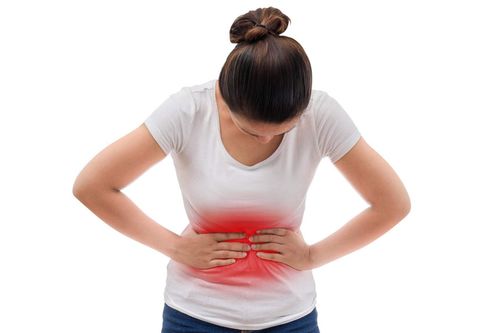This is an automatically translated article.
Irritable bowel syndrome is a functional intestinal disorder that recurs many times with symptoms such as abdominal pain, spasms, bloating, flatulence, diarrhea and constipation... In which, abdominal pain is The main symptoms used to confirm the diagnosis of this condition. Understanding the mechanism, presentation, and location of abdominal pain in irritable bowel syndrome will aid in the early diagnosis and treatment of this condition.
1. What is irritable bowel syndrome?
Irritable bowel syndrome (IBS) is a functional disorder of the gastrointestinal tract commonly found in the colon (large intestine). This syndrome is characterized by symptoms of abdominal pain with bowel disturbances or changes in bowel habits, without any physical damage or anatomical abnormalities in the intestinal tract. Therefore, irritable bowel syndrome is also known as spastic colon syndrome.1.2 Causes The pathogenesis of this irritable bowel syndrome is often related to the following factors:
Diet: Most current digestive disorders in general and irritable bowel syndrome in particular have related to improper diet or eating spoiled food or foods containing harmful substances. Psychophysiology: People who often think, worry, stress or have neuropsychiatric problems such as depression, sleep disorders ... are very susceptible to irritable bowel syndrome. This cause also affects the monitoring and treatment of this syndrome. Other causes: Patients who have had diseases of the gastrointestinal tract, family history, women in the menstrual cycle, use of hormonal drugs, etc. are these factors that give rise to the needs. Abnormal bowel movements, thereby increasing the risk of developing irritable bowel syndrome.
2. Diagnosing irritable bowel syndrome
2.1. Clinical According to Rome IV criteria (2016), irritable bowel syndrome is characterized by recurrent abdominal pain, usually occurring at least 1 day per week and in the last 3 months, associated with 2 or 3 of the following factors:
Abdominal pain associated with defecation. Change in stool shape during defecation. Change in frequency of defecation. 2.2. Subclinical There were no abnormalities in the blood count. Stool test for occult blood or parasites. Abdominal ultrasound, computed tomography (CT-scan) of the abdomen, or abdominal magnetic resonance imaging (MRI) of the abdomen to identify tumors or lesions in the intestinal tract. Colonoscopy is an essential tool in the differential diagnosis of other diseases of the colon. Biopsy, colon histopathology to accurately identify lesions.
3. Where is the painful irritable bowel syndrome?
The pain in irritable bowel syndrome involves the intestinal tract, specifically the colon. Pain in irritable bowel syndrome is usually functional pain, meaning it occurs without any physical damage or anatomical abnormalities in the intestinal tract.
Irritable bowel syndrome pain can be felt in many parts of the body, but most commonly occurs in the lower abdomen (lower abdomen). This symptom usually occurs after eating and may be relieved or aggravated after a bowel movement. It can range from mild to severe, which can be so intense that it is sometimes mistaken for appendicitis or a heart attack.
3.1. Mechanisms of Pain in Irritable Bowel Syndrome Research on irritable bowel syndrome suggests that pain may be caused by oversensitive nerves in the gut. These highly sensitive nerve receptors often overreact to physical stimuli, which then send messages to the brain telling it to be in pain. Millions of nerves and neurons run between the gut and the brain, known as the gut-brain axis. This means that the brain can sense what is happening in the gut and the intestines can sense what is happening in the brain. Receiving constant stimuli makes the brain sensitive to every small change coming from the gut, which in turn causes pain to occur more often and again and again.
3.2. Location of pain in irritable bowel syndrome 3.2.1. Abdominal pain Irritable bowel syndrome is a frequent symptom that can be accompanied by nausea, abdominal pain and bloating. The sensations of abdominal pain often stem from contractions or gas in the intestines, which in turn leads to diarrhea or constipation.
Abdominal pain due to bowel disorders can also be caused by psychological factors such as stress or anxiety. During times of stress, the sympathetic nervous system redirects and reduces blood flow to the intestines, slowing its function.
Abdominal pain usually around the colon:
Lower stomach pain: About 25% of patients have pain at this location, usually relieved after defecation. Right side abdominal pain: accounted for 20%. Left abdominal pain: About 20%. Pain around the navel: About 25%. Epigastric pain: Occurs in about 10% of patients, often accompanied by abdominal distention and may be worse after meals. Factors that increase abdominal pain:
Stress, anxiety, mental disorders, insomnia... Eating a lot of high-fat, high-sugar foods... Female patients in the menstrual cycle. 3.2.2. Back pain Back pain is not a symptom of irritable bowel syndrome, but it is often caused by gas buildup and colon spasms. Studies show that about 68% to 81% of people with irritable bowel syndrome will experience back pain. These pains usually appear first in the intestinal tract, are transmitted by the pelvic nervous system and finally affect the pain-sensing nerves in the back.
The frequency of back pain in patients with irritable bowel syndrome with comorbidities such as spondyloarthritis, rheumatoid arthritis, interstitial cystitis, and fibromyalgia... is more common in normal person.
3.2.3. Chest pain Chest pain can be a symptom of a more serious condition, such as coronary artery disease. However, for people with irritable bowel syndrome, chest pain can be a symptom of gas in the intestinal tract, especially in the stomach or left colon.
Another reason people with irritable bowel syndrome may experience chest pain is that they are four times more likely to develop gastroesophageal reflux disease (GERD). In addition, anatomical analyzes showed that nerves in the heart region were also involved in the esophagus. Thus, patients may think they are experiencing pain of cardiac origin when the pain is actually coming from the esophagus.
3.2.4. Headache or Migraine One theory is that the headaches in irritable bowel syndrome are the result of a relationship between the digestive system and the central nervous system, also known as the brain-gut axis. The vagus nerve (vagal nerve - nerve number X), the longest cranial nerve in the body, connects the brain to the intestines along the gut-brain axis. This nerve transmits signals in two directions, which means it can relay pain signals and information from the brain to the intestines and back. Since the vagus nerve is involved in both headaches and symptoms in irritable bowel syndrome, it is often thought to be involved in overlapping symptoms.
A study published in the Polish Journal of Neurology and Neurosurgery found that between 23% and 53% of people with irritable bowel syndrome experience frequent headaches. Additional research, published in the Journal of BMC Gastroenterology, reports that people with irritable bowel syndrome are about 60 percent more likely to have migraines than those without the syndrome.
3.2.5. Anal and rectal pain Symptoms of anal and rectal pain in patients with irritable bowel syndrome are often associated with hemorrhoids and anal fissures, a complication of chronic constipation. Because constipation can cause stools that are hard, dry, and difficult to pass, anal pain caused by hemorrhoids or an anal fissure is often worse with bowel movements.
A 2017 study that screened 255 people with irritable bowel syndrome noted that 27.8% of those diagnosed with the syndrome also had a history of anal complications, such as anal fissures or hemorrhoids. .
3.2.6. Maxillofacial pain A recent study has shown that people with irritable bowel syndrome are at increased risk for pain and motion damage of the jaw joint and surrounding muscles. This was also explained to be related to the vagus nerve. However, this symptom is less common than pain at other sites.
4. Treating Pain in Irritable Bowel Syndrome
4.1. Non-drug treatment For colic, try peppermint oil, an antispasmodic (such as Buscopan), heat, or try hypnotherapy (Hypnotherapy). Exercises like gentle sit-ups and some yoga poses are known to help get rid of gas in the intestinal tract. Avoid lying down too much during the day. Limit wheat fiber, limit fat intake and avoid carbonated drinks and artificial sweeteners. Use of antacids when gastroesophageal reflux syndrome occurs, however, the treatment should be consulted with a specialist. Treatment of headaches, facial pain is usually indicated using non-steroidal anti-inflammatory drugs (NSAIDs) and Acetaminophen (Tylenol, Paracetamol). However, some NSAIDs such as Advil, Motrin or Aleve can make intestinal symptoms worse. Treatment for anorectal pain usually involves treating hemorrhoids and anal fissures. Other medications used to treat irritable bowel syndrome should be consulted by a specialist. Pain, especially abdominal pain, is one of the common symptoms of irritable bowel syndrome. Early detection and appropriate control measures will help improve the effectiveness of treatment, and at the same time contribute to improving the quality of life for patients and their families.













